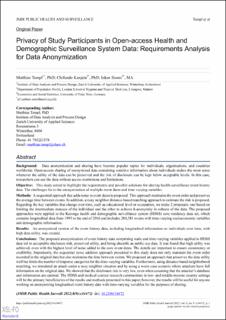Please use this identifier to cite or link to this item:
https://doi.org/10.21256/zhaw-26474| Publication type: | Article in scientific journal |
| Type of review: | Peer review (publication) |
| Title: | Privacy of study participants in open-access health and demographic surveillance system data : requirements analysis for data anonymization |
| Authors: | Templ, Matthias Kanjala, Chifundo Siems, Inken |
| et. al: | No |
| DOI: | 10.2196/34472 10.21256/zhaw-26474 |
| Published in: | JMIR Public Health and Surveillance |
| Volume(Issue): | 8 |
| Issue: | 9 |
| Page(s): | e34472 |
| Issue Date: | 2022 |
| Publisher / Ed. Institution: | JMIR Publications |
| ISSN: | 2369-2960 |
| Language: | English |
| Subjects: | Longitudinal data; Middle-income country; Anonymization; Health and demographic surveillance system; Event history data; Low-income country; Digitalisierung; Gesundheit; Demographie; Anonymisierung; Umgang mit sensiblen Daten |
| Subject (DDC): | 005: Computer programming, programs and data 610: Medicine and health |
| Abstract: | Background: Data anonymization and sharing have become popular topics for individuals, organizations, and countries worldwide. Open-access sharing of anonymized data containing sensitive information about individuals makes the most sense whenever the utility of the data can be preserved and the risk of disclosure can be kept below acceptable levels. In this case, researchers can use the data without access restrictions and limitations. Objective: This study aimed to highlight the requirements and possible solutions for sharing health surveillance event history data. The challenges lie in the anonymization of multiple event dates and time-varying variables. Methods: A sequential approach that adds noise to event dates is proposed. This approach maintains the event order and preserves the average time between events. In addition, a nosy neighbor distance-based matching approach to estimate the risk is proposed. Regarding the key variables that change over time, such as educational level or occupation, we make 2 proposals: one based on limiting the intermediate statuses of the individual and the other to achieve k-anonymity in subsets of the data. The proposed approaches were applied to the Karonga health and demographic surveillance system (HDSS) core residency data set, which contains longitudinal data from 1995 to the end of 2016 and includes 280,381 events with time-varying socioeconomic variables and demographic information. Results: An anonymized version of the event history data, including longitudinal information on individuals over time, with high data utility, was created. Conclusions: The proposed anonymization of event history data comprising static and time-varying variables applied to HDSS data led to acceptable disclosure risk, preserved utility, and being sharable as public use data. It was found that high utility was achieved, even with the highest level of noise added to the core event dates. The details are important to ensure consistency or credibility. Importantly, the sequential noise addition approach presented in this study does not only maintain the event order recorded in the original data but also maintains the time between events. We proposed an approach that preserves the data utility well but limits the number of response categories for the time-varying variables. Furthermore, using distance-based neighborhood matching, we simulated an attack under a nosy neighbor situation and by using a worst-case scenario where attackers have full information on the original data. We showed that the disclosure risk is very low, even when assuming that the attacker’s database and information are optimal. The HDSS and medical science research communities in low- and middle-income country settings will be the primary beneficiaries of the results and methods presented in this paper; however, the results will be useful for anyone working on anonymizing longitudinal event history data with time-varying variables for the purposes of sharing. |
| URI: | https://digitalcollection.zhaw.ch/handle/11475/26474 |
| Fulltext version: | Published version |
| License (according to publishing contract): | CC BY 4.0: Attribution 4.0 International |
| Departement: | School of Engineering |
| Organisational Unit: | Institute of Data Analysis and Process Design (IDP) |
| Appears in collections: | Publikationen School of Engineering |
Files in This Item:
| File | Description | Size | Format | |
|---|---|---|---|---|
| 2022_Templ-Kanjala-Siems_Privacy-study-participants-surveillance-system-data_jmir.pdf | 594.95 kB | Adobe PDF |  View/Open |
Show full item record
Templ, M., Kanjala, C., & Siems, I. (2022). Privacy of study participants in open-access health and demographic surveillance system data : requirements analysis for data anonymization. JMIR Public Health and Surveillance, 8(9), e34472. https://doi.org/10.2196/34472
Templ, M., Kanjala, C. and Siems, I. (2022) ‘Privacy of study participants in open-access health and demographic surveillance system data : requirements analysis for data anonymization’, JMIR Public Health and Surveillance, 8(9), p. e34472. Available at: https://doi.org/10.2196/34472.
M. Templ, C. Kanjala, and I. Siems, “Privacy of study participants in open-access health and demographic surveillance system data : requirements analysis for data anonymization,” JMIR Public Health and Surveillance, vol. 8, no. 9, p. e34472, 2022, doi: 10.2196/34472.
TEMPL, Matthias, Chifundo KANJALA und Inken SIEMS, 2022. Privacy of study participants in open-access health and demographic surveillance system data : requirements analysis for data anonymization. JMIR Public Health and Surveillance. 2022. Bd. 8, Nr. 9, S. e34472. DOI 10.2196/34472
Templ, Matthias, Chifundo Kanjala, and Inken Siems. 2022. “Privacy of Study Participants in Open-Access Health and Demographic Surveillance System Data : Requirements Analysis for Data Anonymization.” JMIR Public Health and Surveillance 8 (9): e34472. https://doi.org/10.2196/34472.
Templ, Matthias, et al. “Privacy of Study Participants in Open-Access Health and Demographic Surveillance System Data : Requirements Analysis for Data Anonymization.” JMIR Public Health and Surveillance, vol. 8, no. 9, 2022, p. e34472, https://doi.org/10.2196/34472.
Items in DSpace are protected by copyright, with all rights reserved, unless otherwise indicated.